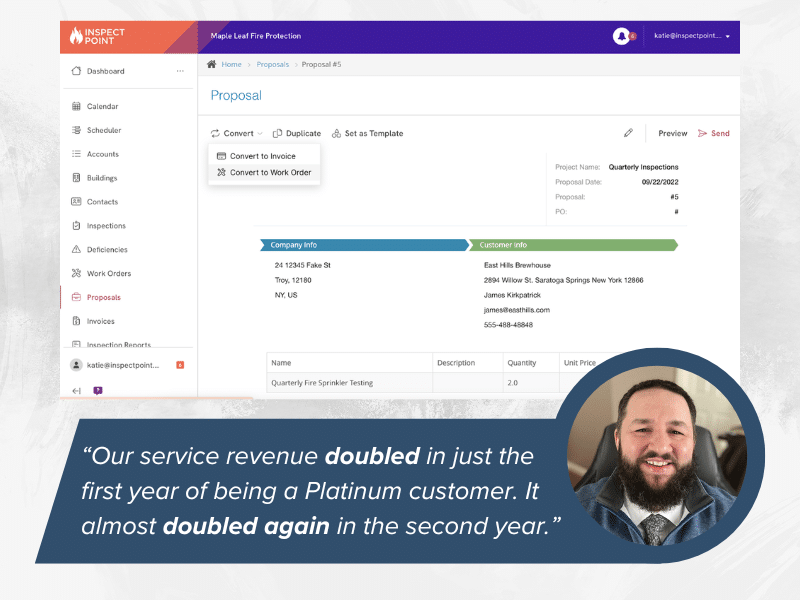
At Inspect Point, when we say we’ve got you covered from inspection to collection, we mean it. As a former Inspect Point user and current Inspect Point employee, I’ve seen this from both sides. When it comes to managing the entire lifecycle of a deficiency, there’s no better platform.
The Way Things Worked–and Didn’t Work
When I was Inspection Manager at Hampshire Fire Protection, we implemented Inspect Point at the Silver tier. We initially just wanted to use Inspect Point for inspections–it enabled us to manage our own questions and create professional reports. That’s all we thought we needed at the time.
For the first year, it fit our needs perfectly–we saw a lot of benefits in streamlining our inspection process and developing those highly professional reports. We were able to include itemized information, load all the inspection details in one go, and access historical inspection data. We got to live off the fruit of the work we did upfront for each customer.
But inspections are not where many fire protection businesses make most of their money. Often, the real revenue comes from service work and work on renovations or new construction projects. Inspections are the “foot in the door” that leads to the really big deals. Being on Inspect Point’s Silver tier professionalized our inspection department. But we wanted to make that critical connection between inspections and service work the way we (and our customers) needed.
Deficiencies by the Truckload
While the inspection side of our business was on the Silver tier, our service department used a different platform for deficiency quoting. We identified and recorded a lot of deficiencies, but they weren’t on the same conveyor belt between the inspection and service departments. The disconnect meant those deficiencies did not move seamlessly from inspection to proposal to work order to resolution–and, at the end of it all, to invoicing and payment.
Let’s consider what that means practically. If you’ve got six inspectors conducting three inspections a day and identifying three deficiencies at each inspection–your company might see more than 50 new deficiencies every day, which is not at all uncommon. If the inspection and service departments operate on different systems, communicating those deficiencies and making sure they get taken care of is not an easy task. And it certainly wasn’t for us at Hampshire. Moving data from one platform to another meant repetitive manual entry and tedious processes that took far too long.
Bridging the divide between the inspection and service departments meant a direct, comprehensive flow of information and better service to our customers.
Deficiencies would just float off into the ether, not getting quoted or fixed. When inspectors showed up for the next inspection, the inspector and customer would both get frustrated. We’d hear things like, “Why are you guys here? I haven’t even received a quote for the deficiencies you found last time.” Because customers depend on deficiencies getting quoted and corrected for reporting and insurance purposes, not addressing deficiencies became a huge problem. Eventually, we got so far behind on quoting and correcting deficiencies that we knew we needed a more comprehensive solution.
Making the Move & Bridging the Gap
Once the team took the plunge and upgraded to the Platinum tier–which added proposals and work orders to the Inspect Point workflow–the impact was undeniable. Our back office immediately saw the benefits of managing the lifecycle of deficiencies within a single platform. The process was simple and effective:
- The inspector sees the deficiency in the field, notes it, and sends it back to the office in a report.
- The back office generates a proposal based on the deficiency, then a work order, carrying over all the information for the service technician to refer to.
- The technician resolves the deficiency in the field and generates a clean report for the customer.
All this takes place in one platform, so you can easily bring key information from one stage to the next and maintain an audit trail for your work. Our customers were happy: They were meeting fire department requirements and getting better insurance rates. And my company was happy: We were growing and driving revenue. In fact, our service revenue doubled in just the first year of being a Platinum customer. It almost doubled again in the second year.
Bridging the divide between the inspection and service departments meant a direct, comprehensive flow of information and better service to our customers. We no longer had a long list of deficiencies that went unaddressed. If anything, our biggest issue was that we generated so much service work we had to hire more technicians–a great problem to have.
The most significant difference we discovered when upgrading from Silver to Platinum is that we became proactive rather than reactive in every area of our business. Using a single system for inspections, proposals, and work orders allowed us to address deficiencies for all our customers, ensuring their safety and our success.

